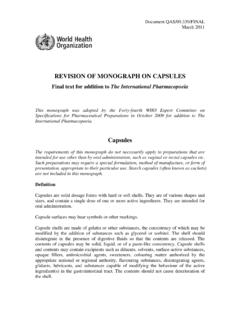Transcription of What You Should Know About Bacterial Vaginosis
1 The Female PatientWhat s the most common vaginal infection? Nope, it s not a yeast infection! Bacterial Vaginosis (BV) is the most frequent cause of abnormal vaginal discharge. But unlike the more familiar terms vaginitis or yeast infection, many women still do not recognize the term BV or understand the infection that it Vaginitis Is Not AlikeThe word vaginitis is a general term mean-ing vaginal infection, or inflammation (irrita-tion and swelling) of the vaginal tissue. Many bacteria live in your vagina. Most of them are good bacteria, including important ones called lactobacilli, but a few are bad. Sometimes con-ditions inside the vagina change, shifting the balance of good and bad bacteria. The result can be one of the following types of vaginitis:Yeast Infection.
2 This is caused by one of the usual vaginal residents, a fungus called Candida. Certain conditions, such as diabe-tes, pregnancy, or human immunodeficiency virus (HIV); or medications such as steroids or antibiotics, can cause these fungi to grow and multiply. The result is itching, irritation, and sometimes a discharge often described as looking like cottage This is sometimes called trich, and is caused by the sexually transmit-ted parasite Trichomonas vaginalis. Women who have trichomoniasis often have a frothy, yellow discharge and irritation or Vaginosis . This is caused by a mix-ture of bacteria that come from your skin and bowel. When the balance of good and bad bacteria is altered by such things as douching, changing sexual partners, or sexually transmit-ted infections (STIs), conditions are right for these bacteria to flourish.
3 Although BV is not considered an STI (the bacteria come from your own body, not from a sexual partner), it occurs more often in women who are having sex than those who are some women with BV don t know they have it, many experience unpleasant symp-toms such as itching, irritation, and a vaginal dis-charge with a bad odor, often described as fishy. Bacterial Vaginosis is treatable and curable. It is particularly important that pregnant women be tested and treated, since women with BV are more likely to have miscarriages or premature labor and birth. Bacterial Vaginosis has been linked to pelvic inflammatory disease, which can cause scarring in the fallopian tubes. It may also make it more difficult to become pregnant and easier to acquire Bacterial VaginosisThere are many products available without a prescription to treat yeast infections.
4 So when women develop vaginal discomfort, they may think they have a yeast infec-What You Should Know AboutBacterial Vaginosis8/06 The Female Patient grants permission to reproduce this handout for the purposes of patient education. PATIENT HANDOUTIt is particularly important that pregnant women be tested and treated, since women with BV are more likely to have miscarriages or premature labor and and simply use an over-the-counter (OTC) product. If you have a first-time vaginal infec-tion, or if you have the symptoms described earlier, resist the temptation to do this. Remember, BV, not yeast, is the most common vaginal infection and yeast infection treat-ments do not cure BV. Instead, call your health care provider and make it clear that you need an appointment within a few days.
5 You may be advised to speak with your health care provider or office staff for a telephone diagnosis. Because the symptoms of different vaginal infections can overlap, it s hard for health care providers to know what you have just by asking questions over the phone. Tell the office staff you want to have your infec-tion diagnosed in your appointment, your health care provider will ask About your symptoms and examine your vulva and vagina. This includes taking a sample of discharge to determine the pH (acid/base balance), or a DNA test; checking for the fishy odor which is characteristic of BV; and examining the sample under a microscope. Do not assume that your health care provider is taking a Papanicolaou (Pap) smear or testing you for STIs; these tests are not automatically done during an exam for vaginal infections.
6 If you have recently changed sexual partners, or if you are aged 25 years or younger, request specific tests for STIs. If your health care pro-vider doesn t tell you exactly what tests are being done, ask her or Bacterial VaginosisTwo antibiotics, clindamycin and metronidazole, can cure BV, and both are available either as oral tablets or as vaginal creams. Clindamycin also comes as a vaginal suppository. Pregnant women Should take oral medications since creams and suppositories don t work as well for preventing the harmful effects of BV dur-ing pregnancy. Neither antibiotic is considered harmful to the you take oral metronidazole you will be instructed not to drink alcohol during treatment because the combination causes severe nausea and vomiting.
7 Oral clindamycin can cause severe persistent diarrhea; if you develop diarrhea while using it, notify your health care provider. vaginal creams have fewer side effects, although some women find them a bit messy to use. Sexual partners do not need to be Vaginosis ordinarily goes away with treatment, but it may persist or return. If your symptoms do not clear up, or if they come back, you Should return to your health care provider to verify the presence of BV. Using an extended regimen of twice weekly metronidazole vaginal cream may clear up persistent or recurrent may have heard that eating yogurt, or using lactobacillus capsules or suppositories can help prevent vaginal infections, including BV; however, there is no good scientific evidence that this works.
8 Using condoms, practicing sex-ual abstinence, having one rather than multiple sexual partners, and avoiding douching all help keep the vagina healthy and less prone to SummaryBacterial Vaginosis , the most common vaginal infection, is not sexually transmitted, and it is treatable and curable. If you have symptoms, having an in-office examination, rather than buying an OTC product or having a telephone consultation is the best way to get an accurate diagnosis and the most appropriate Patient Handout was prepared by Diane E. Judge, APN/CNP, using materials from Sexually Transmitted Diseases Guidelines 2002, MMWR Recommendations and Reports, May 10, 2002; 51(RR06). The Female Patient grants permission to reproduce this handout for the purposes of patient education.
9 8/06 The National Women s Health Information Center US Department of Health and Human Services Office on Women s Health 1-800-994-9662 American Social Health Association VaginosisBecause the symptoms of different vaginal infections can overlap, it s hard for health care providers to know what you have just by asking questions over the phone.








